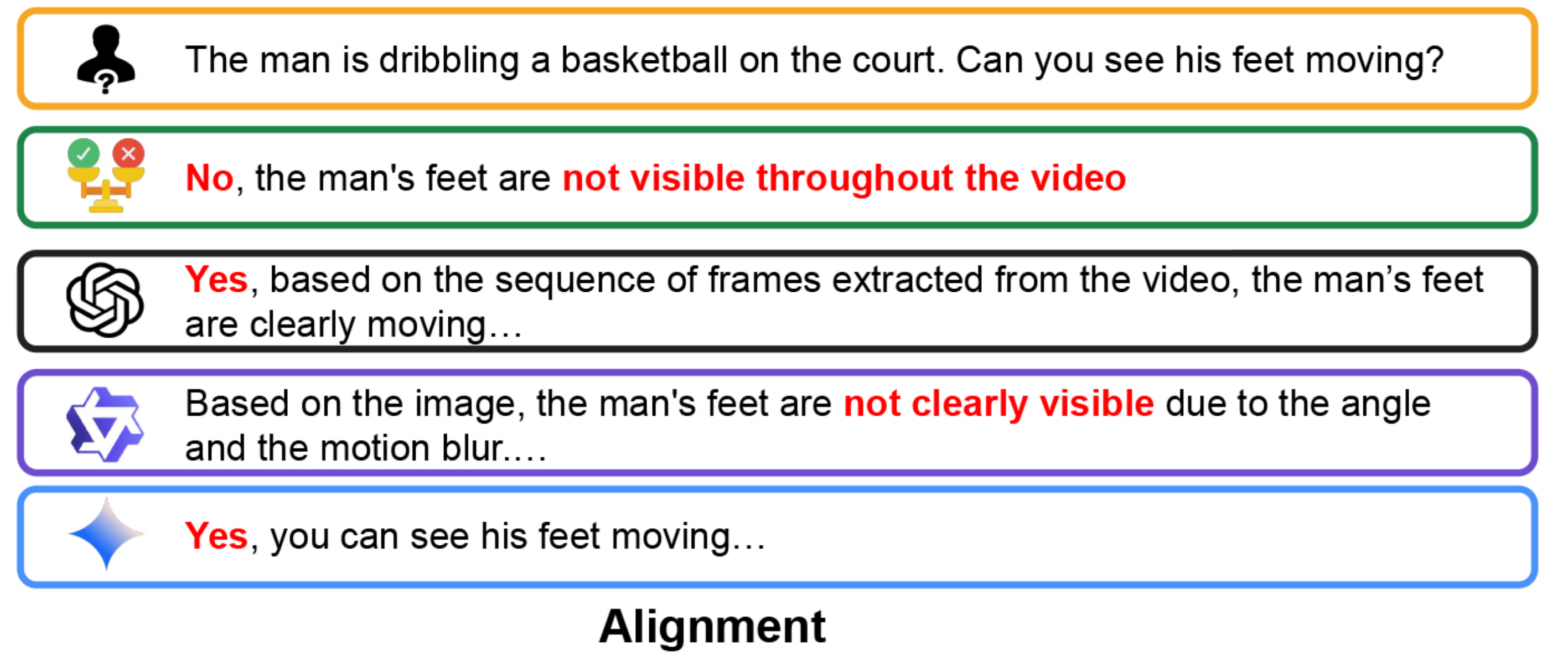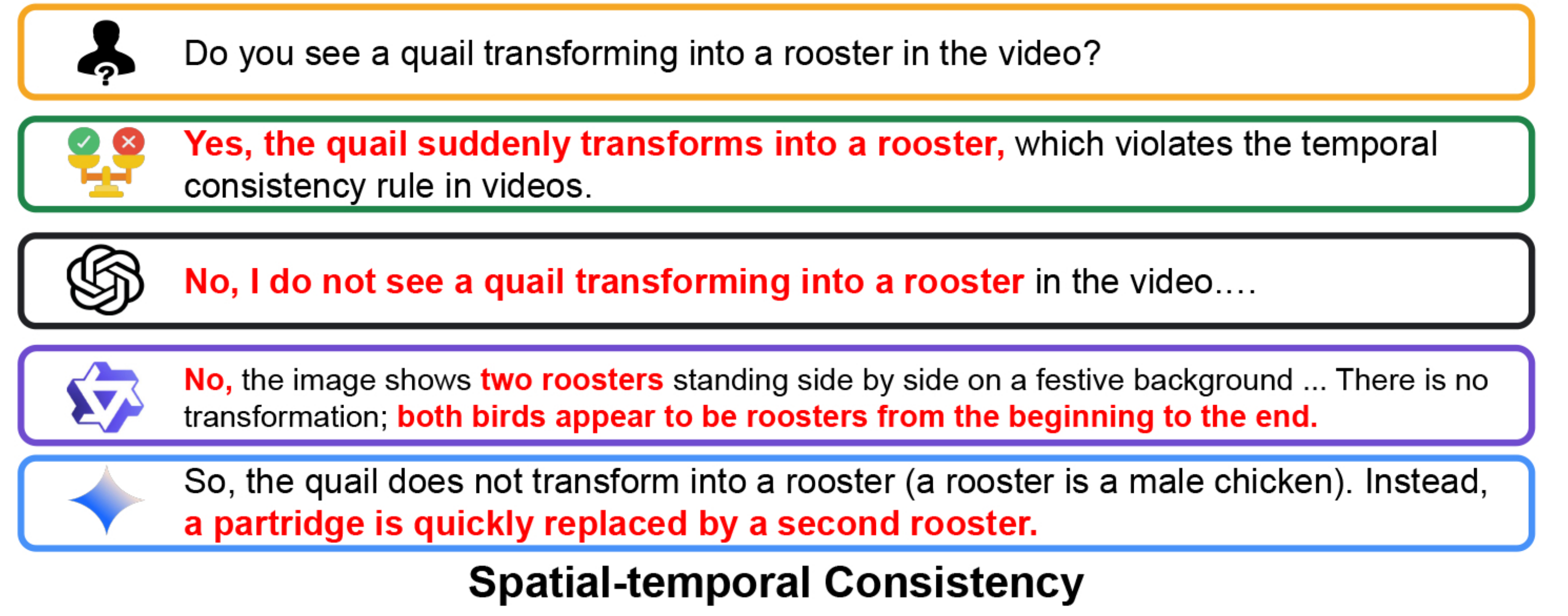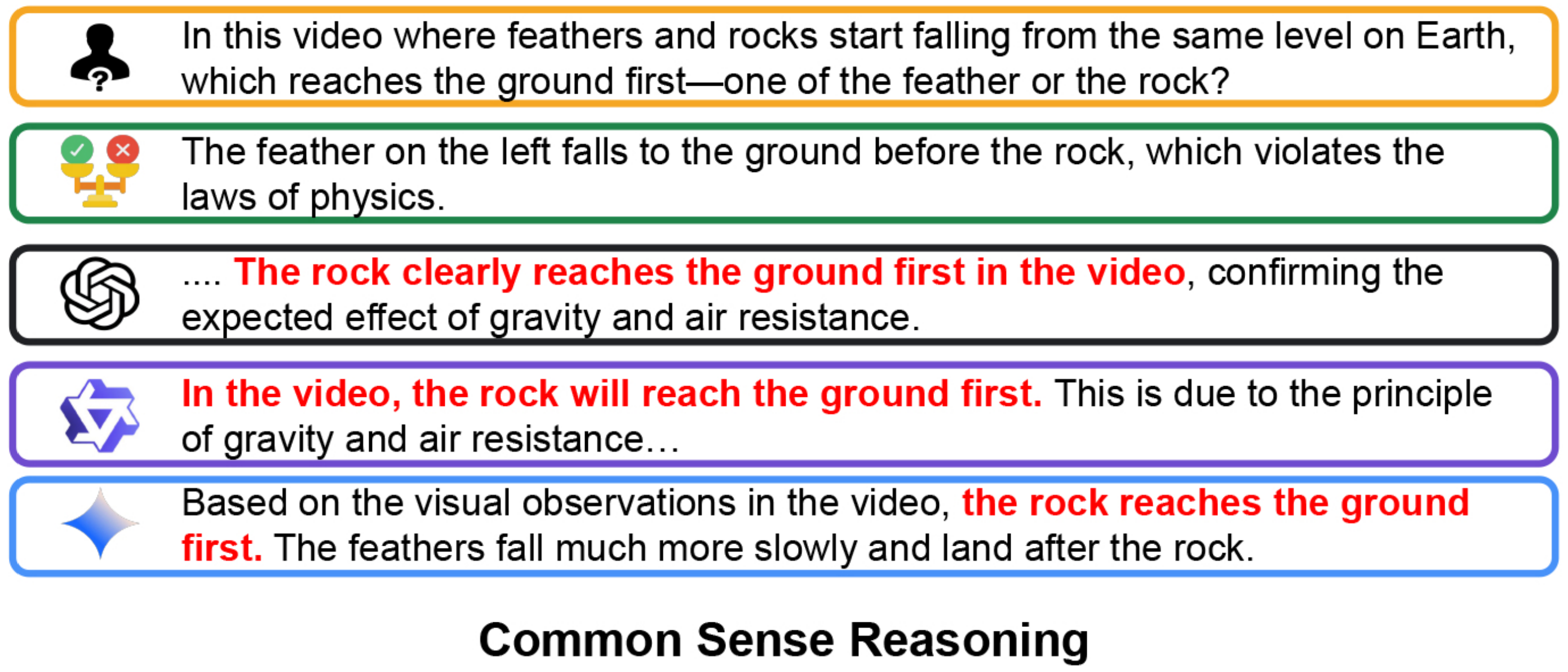Datasets:
language:
- en
license: apache-2.0
task_categories:
- video-text-to-text
VideoHallu: Evaluating and Mitigating Multi-modal Hallucinations for Synthetic Videos
Zongxia Li*, Xiyang Wu*, Guangyao Shi, Yubin Qin, Hongyang Du, Tianyi Zhou, Dinesh Manocha, Jordan Lee Boyd-Graber
[📖 Paper] [🤗 Dataset] [🌍Website]

👀 About VideoHallu
Synthetic video generation has gained significant attention for its realism and broad applications, but remains prone to violations of common sense and physical laws. This highlights the need for reliable abnormality detectors that understand such principles and are robust to hallucinations. To address this, we introduce VideoHallu, a benchmark of over 3,000 video QA pairs built from synthetic videos generated by models like Sora, Veo2, Kling, paired with expert-crafted counterintuitive QA to evaluate the critical thinking abilities of Multi-modal Large Language Models (MLLMs) on abnormalities that are perceptually obvious to humans but often hallucinated due to language priors. VideoHallu evaluates MLLMs' abnormality detection abilities with examples across alignment, consistency, commonsense, and physics. We benchmark SOTA MLLMs, including GPT-4o, Gemini-2.5-Pro, Qwen-2.5-VL, and forefront models like Video-R1 and VideoChat-R1. We observe that these models perform well on many real-world benchmarks like MVBench and MovieChat, but still struggle with basic physics-based and commonsense reasoning in synthetic videos. We further show that post-training with Group Relative Policy Optimization (GRPO), using curriculum learning on datasets combining video QA with counterintuitive commonsense and physics reasoning over real and synthetic videos, improves MLLMs’ abnormality detection and critical thinking, demonstrating the value of targeted training for improving their understanding of commonsense and physical laws.
🔥 News
- [2025/05/02] We expand our dataset with more QA pairs🤗.
- [2025/05/02] We release our datasets🤗.
- [2025/05/02] We release our GRPO free-form RewardModel🤗.
Table of Contents
- Benchmark
- Getting Started
- The Dawn of MLLMs in Synthetic Videos
- Evaluation over SoTA MLLMs
- Reward Model
- Training
- Fine-tuning Results
- Acknowledgements
- Citations
🔍 Benchmark
We design our benchmark, VideoHallu, with four question categories to probe hallucinations in synthetic video understanding, covering perceptual understanding to abstract reasoning:
- Alignment checks if the model correctly identifies and understands entities using visual and textual cues.
- Spatial-temporal Consistency examines whether the model can track entity motion across frames.
- Common Sense Reasoning tests if the model can reason based on its knowledge.
- Physics assesses if the model applies physical laws to entity motions and procedural understanding.
Each question in a category may also be assigned to multiple sub-categories, depending on the specific aspects it targets. Detailed annotations and sub-category breakdowns are available here:
| Updated on | HuggingFace | Dataset Size |
|---|---|---|
| May, 2, 2025 | HuggingFace | 3233 |
Below is an overview of our benchmark’s organization, including the high-level question categories, ranked by the level of reasoning required by MLLMs, and their corresponding sub-category breakdowns.

📖 Getting Started
To set up our benchmark, please follow the steps provided below:
# Download the synthetic dataset
pip install huggingface_hub
# Download data to your local dir
huggingface-cli download IntelligenceLab/VideoHallu --repo-type dataset --local-dir ./new_video_folders --local-dir-use-symlinks False
# Download and unzip the physben training data videos
curl -L -o video.part1.rar https://huggingface.co/datasets/WeiChow/PhysBench-train/resolve/main/video.part1.rar
# Unzip data (linux system)
unrar x video.part1.rar
🧠 The Dawn of MLLMs in Synthetic Videos
We collect hallucination cases observed during SOTA MLLM evaluations on synthetic video tasks. Each example includes the generation prompt, key frames, questions, human-annotated ground truth, and hallucinated answers from GPT-4o, Qwen2.5-VL, and Gemini-2.5-Pro, with hallucinations marked in red to assist the reader's understanding. More examples can be found in the Appendix of our paper.
Note: The legend below explains all the symbols used to represent the State-of-the-Art (SoTA) MLLMs featured in our showcases for synthetic video generation and video question-answering.

Alignment
🗣️ Video Generation Prompt: A young male athlete is playing basketball on an outdoor court, performing impressive dribbling and slam dunks.
🎬 Synthetic Video:

🤖 Video Question-Answering by MLLMs:

Spatial-temporal Consistency
🗣️ Video Generation Prompt: Generate a quail and a rooster celebrating New Year.
🎬 Synthetic Video:

🤖 Video Question-Answering by MLLMs:

Common Sense Reasoning
🗣️ Video Generation Prompt: A feather and a heavy rock are released at the same height and begin to fall to the ground on Earth.
🎬 Synthetic Video:

🤖 Video Question-Answering by MLLMs:

Physics
🗣️ Video Generation Prompt: Generate the sequence showing a bullet being shot into a watermelon.
🎬 Synthetic Video:

🤖 Video Question-Answering by MLLMs:

📊 Evaluation over SoTA MLLMs
We evaluate diverse SoTA models across sizes and training strategies, reporting both overall and sub-category accuracies. Qwen2.5-VL-32B achieves the highest overall performance among all models.

We evaluate SoTA MLLMs on VideoHallu, with results broken down by sub-category. From left to right, we show: (a) models under 7B parameters; (b) models between 7B–38B; (c) R1 fine-tuned models; and (d) large black-box MLLMs. While many perform well on alignment tasks, they remain prone to hallucinations in reasoning-heavy tasks, with notably weaker performance on physics and commonsense reasoning.

🏅 Reward Model
We use ModernBERT as the base model to finetune on MOCHA, Prometheus-preference, Pedants to evaluate free-form text generations. We use RewardBert as the reward in GRPO finetuning.
Method: compute_score
Parameters
reference_answer(list of str): A list of gold (correct) answers to the questioncandidate_answer(str): The answer provided by a candidate that needs to be evaluated
Returns
tuple: A tuple of normalized and raw scores.
from qa_metrics.RewardBert import RewardBert
rb = RewardBert(device='cuda')
reference_answer = "The Frog Prince"
candidate_answer = "The movie \"The Princess and the Frog\" is loosely based off the Brother Grimm's \"Iron Henry\""
rb.compute_score(reference_answer, candidate_answer)
# (0.29113227128982544, 2.1645290851593018)
🚀 Training Set up
We adopt Video-R1 training code to fine-tune the model.
Use our formatted JSON files (synthetic_data_split.json and physbench_train_split.json) and follow their setup to train a model.
📊 Fine-tuning Results
We evaluate models fine-tuned on either domain-specific sub-datasets or curriculum-based composite datasets. Results show that models trained only on general real-world videos yield little to no gains on synthetic video understanding. Incorporating general physics data improves physics reasoning, and a curriculum starting with real-world physics followed by synthetic data leads to a 2.8% performance boost.

We show results for (a) previous SoTA MLLMs, (b) models fine-tuned on sub-datasets, and (c) models fine-tuned on the full dataset via curriculum learning. Compared to the baseline (Qwen2.5-VL-7B), reinforcement fine-tuning on commonsense and physics data improves models' reasoning and overall performance in synthetic video understanding.

Acknowledgement
We sincerely appreciate the contributions of the open-source community. The related projects are as follows: R1-V , DeepSeek-R1 , Video-R1, Qwen-2.5-VL
Citations
If you find our work helpful for your research, please consider citing our work.
@misc{li2025videohalluevaluatingmitigatingmultimodal,
title={VideoHallu: Evaluating and Mitigating Multi-modal Hallucinations for Synthetic Videos},
author={Zongxia Li and Xiyang Wu and Yubin Qin and Guangyao Shi and Hongyang Du and Dinesh Manocha and Tianyi Zhou and Jordan Lee Boyd-Graber},
year={2025},
eprint={2505.01481},
archivePrefix={arXiv},
primaryClass={cs.CV},
url={https://arxiv.org/abs/2505.01481},
}
@misc{li2025surveystateartlarge,
title={A Survey of State of the Art Large Vision Language Models: Alignment, Benchmark, Evaluations and Challenges},
author={Zongxia Li and Xiyang Wu and Hongyang Du and Fuxiao Liu and Huy Nghiem and Guangyao Shi},
year={2025},
eprint={2501.02189},
archivePrefix={arXiv},
primaryClass={cs.CV},
url={https://arxiv.org/abs/2501.02189},
}
@misc{guan2024hallusionbenchadvanceddiagnosticsuite,
title={HallusionBench: An Advanced Diagnostic Suite for Entangled Language Hallucination and Visual Illusion in Large Vision-Language Models},
author={Tianrui Guan and Fuxiao Liu and Xiyang Wu and Ruiqi Xian and Zongxia Li and Xiaoyu Liu and Xijun Wang and Lichang Chen and Furong Huang and Yaser Yacoob and Dinesh Manocha and Tianyi Zhou},
year={2024},
eprint={2310.14566},
archivePrefix={arXiv},
primaryClass={cs.CV},
url={https://arxiv.org/abs/2310.14566},
}
@misc{wu2024autohallusionautomaticgenerationhallucination,
title={AutoHallusion: Automatic Generation of Hallucination Benchmarks for Vision-Language Models},
author={Xiyang Wu and Tianrui Guan and Dianqi Li and Shuaiyi Huang and Xiaoyu Liu and Xijun Wang and Ruiqi Xian and Abhinav Shrivastava and Furong Huang and Jordan Lee Boyd-Graber and Tianyi Zhou and Dinesh Manocha},
year={2024},
eprint={2406.10900},
archivePrefix={arXiv},
primaryClass={cs.CV},
url={https://arxiv.org/abs/2406.10900},
}